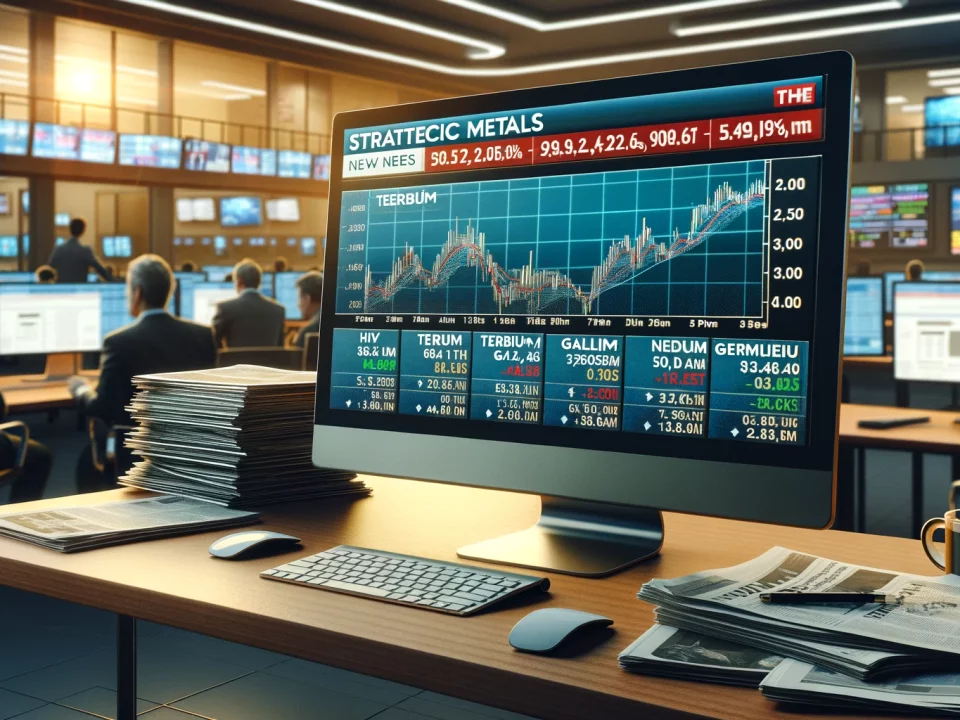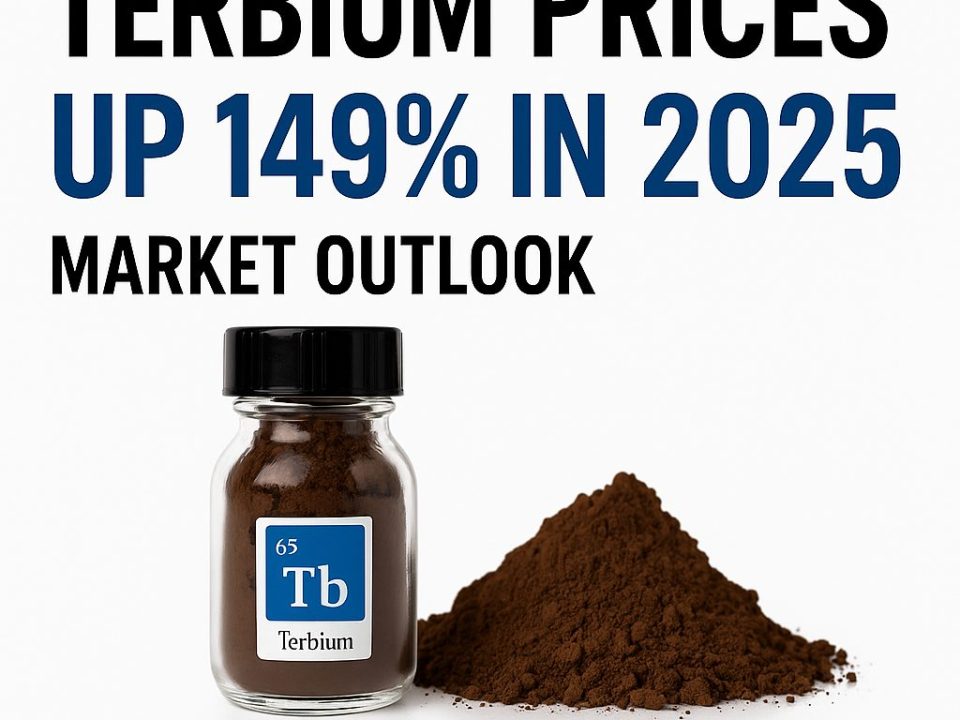
Gallium Update: Up 32.5% So Far in 2025
October 28, 2025
Press Release: Strategic Metals Invest Highlights Growing Importance of Rare Earths as Physical Assets Following Trump–Xi Trade Truce
November 2, 2025This week, U.S. President Donald Trump’s Asia tour ahead of the APAC summit in South Korea captured headlines, with significant developments in trade and critical minerals taking center stage. At the summit, Trump and Chinese President Xi Jinping reportedly made substantial progress on trade issues, including those related to rare earths.
All this and more from the editorial team @rawmaterials.net
AUSTRALIA: LYNAS REPORTS RECORD QUARTER, EXPANDS JAPAN SUPPLY CHAIN –
Australian rare earth giant Lynas has reported record quarterly results for the three months ended September 30, 2025 (PDF). The company delivered gross sales revenue of $130 million (A$200 million), up 18 per cent from the previous quarter, with total rare earth oxide (REO) production rising to 3,993 tons, including 2,003 tons of neodymium-praseodymium (NdPr). However, despite posting record results, the figures fell short of analysts’ expectations, Reuters reported.
In the quarter, Lynas also achieved its first commercial shipments of heavy rare earth oxides, including dysprosium and terbium. In addition, production and commissioning activities advanced at the company’s Mt Weld and Malaysia operations, alongside the commissioning of renewable energy facilities at its hybrid power station. On Wednesday, Lynas also announced plans to expand heavy rare-earth separation activities at its Malaysian facilities (as we reported).
In another development for supply chain diversification, Japan’s Sojitz Corporation announced (PDF) that it has begun importing heavy rare earths produced by Lynas, marking the first import of Australian-sourced rare earths refined in Malaysia. Sojitz, through its joint venture Japan Australia Rare Earths (JARE) with JOGMEC, has been a long-term investor and distributor for Lynas in Japan. The move strengthens Japan’s access to critical minerals amid subdued imports from China over the past few months.
MALAYSIA: LYNAS TO EXPAND HEAVY RARE EARTH OPERATIONS –
Australian rare earths producer Lynas Rare Earths has announced plans to establish a new heavy rare earth separation facility in Malaysia. The new plant will complement Lynas’ existing Malaysian operations, which currently produce light rare earth elements, as well as dysprosium and terbium oxides, key precursors for the manufacture of high-performance permanent magnets.
According to Lynas, the facility will have the capacity to process up to 5,000 tons of feedstock per year, sourced from its Mt Weld deposit in Western Australia and other potential feed sources under development. It will produce separated samarium, gadolinium, yttrium, and lutetium, in addition to dysprosium and terbium.
Despite the large feedstock capacity, the yields of terbium and dysprosium will remain low —around 1% for terbium and 5% for dysprosium of the total processed material —highlighting the challenge of scaling up production of these elements. Currently, China accounts for over 90% of global capacity for separating dysprosium and terbium, giving it a near-monopoly.
Lynas noted that the new facility could later be expanded to produce additional heavy rare earth products, including europium, holmium, ytterbium, and erbium, subject to offtake agreements. Earlier this month, China expanded its export control list to include these four elements, as well as thulium, bringing the total number of rare earth elements requiring export licenses to 12 out of 17.
US AND JAPAN TO DEEPEN COOPERATION ON CRITICAL MINERALS:
The two countries will coordinate investment, permitting, and stockpiling measures to diversify supply chains.
U.S. President Donald Trump and Japanese Prime Minister Sanae Takaichi signed a framework agreement in Tokyo on Tuesday to deepen cooperation in the mining and processing of critical minerals, including rare-earth elements. The deal aims to secure supplies for key industries and reduce dependence on China, which dominates global processing capacity.
According to the White House text, both sides intend to mobilize government and private-sector funding for new mining and processing projects, using grants, loans, guarantees, or equity participation. The agreement also outlines plans for financial support within six months for selected projects that will produce end products such as permanent magnets, batteries, catalysts, and optical materials for buyers in the U.S., Japan, and partner countries.
A new response group, led by the U.S. Secretary of Energy and Japan’s Minister of Economy, Trade, and Industry, will identify vulnerabilities and coordinate supply resilience measures. The framework also provides for streamlined permitting, cooperation on recycling technologies, and consideration of complementary stockpiling systems.
The deal with Japan follows a similar critical minerals agreement signed during Trump’s current Asia visit with Malaysia, as well as other trade deals with Cambodia, Thailand, and Vietnam, ahead of his scheduled meeting with China’s President Xi Jinping on Thursday at the APEC summit in South Korea.
UNITED STATES: RAMACO RESOURCES TO ESTABLISH CRITICAL RARE EARTH STOCKPILE:
Latest U.S. initiative to create domestic stockpiles.
U.S. mining company Ramaco Resources plans to establish a national critical minerals stockpile at its Brook Mine in Wyoming, the company announced Monday. The Strategic Critical Minerals Terminal (SCMT) will store rare earth elements and other critical minerals for both government and private industry. Ramaco said it plans to integrate extraction, processing, and secure storage into a single operation. The site could serve as a domestic hub linking miners and manufacturers, and the company is considering offering tolling and storage services to other producers.
Growing U.S. Stockpile Initiatives:
The announcement comes amid growing federal efforts to strengthen U.S. mineral security. The “One Big Beautiful Bill Act,” signed in July 2025, allocates $2 billion to expand the National Defense Stockpile and marks a broader shift toward direct federal procurement and stockpiling.
In August 2025, private firms M2i Global and Volato Group, backed by the Departments of Defense and Energy, announced plans for a Strategic Mineral Reserve (SMR) at the Hawthorne Army Depot in Nevada (we reported). The facility will store gallium, graphite, copper, and other materials while investing in domestic refining capacity.
US AND MALAYSIA SIGN CRITICAL RARE EARTHS AND TRADE AGREEMENT:
The deal covers trade, joint investment, and cooperation in rare earth processing.
Over the weekend at the ASEAN-U.S. Business and Investment Summit in Kuala Lumpur, President Donald Trump and Malaysian Prime Minister Anwar Ibrahim signed a Memorandum of Understanding (MoU) on critical minerals, marking a significant step in U.S.-Malaysia economic and resource cooperation. The MoU commits both countries to strengthening collaboration across the entire critical minerals supply chain —from exploration and extraction to processing, manufacturing, recycling, and recovery —while promoting resilient, secure markets for rare earth elements.
Malaysia, home to major rare-earth processing facilities, including those operated by Australia’s Lynas, pledged preferential market access for U.S. chemicals, machinery, metals, passenger vehicles, and agricultural exports. The MoU is also accompanied by a trade agreement addressing digital trade, services, and investment, while restricting unauthorized transfers of U.S.-controlled items. Under the deals, the two countries will prioritize U.S. investment in Malaysia’s critical minerals sector and coordinate policies to protect domestic markets from unfair trade practices.
However, besides the U.S., China is also interested in greater cooperation with Malaysia on rare earth elements: earlier this month, media reports suggested that the two discussed potential collaboration (we reported).
At the same summit, the U.S. also inked trade and investment agreements with Cambodia, Thailand, and Vietnam, the latter of which is notably home to substantial rare-earth reserves. On the sidelines, U.S. officials also held preliminary talks with Chinese representatives on rare earth exports and tariffs, paving the way for Trump and Xi Jinping to consider a framework agreement later this week.
CHINA AND US LAY OUT TRADE CONSENSUS: CHINA SILENT ON RARE EARTHS-
Talks pave the way for President Donald Trump and Xi Jinping to finalize a possible deal this week.
Chinese and U.S. officials said they reached a preliminary consensus after two days of trade talks in Kuala Lumpur, paving the way for Presidents Donald Trump and Xi Jinping to consider a framework agreement later this week. But while Washington emphasizes progress on tariffs and rare earths, Beijing’s official account made no mention of the critical minerals that have become a flashpoint in recent trade tensions.
U.S. Treasury Secretary Scott Bessent said Sunday that the talks paved the way to cancel Trump’s planned 100% tariffs on Chinese imports in exchange for China postponing for one year the implementation of its new rare-earth export licensing regime, the Financial Times reports, among others.
Rare Earth Supply China Increasingly Tight:
China expanded its export license requirements earlier this month to cover five additional rare earth elements and a range of related processing technologies. China’s rare earth exports in September fell to their lowest level this year, further highlighting tightening supply chains.
In a statement, China’s Ministry of Commerce confirmed that Vice Premier He Lifeng met with Bessent and U.S. Trade Representative Jamieson Greer for “frank, in-depth and constructive exchanges” on issues including Section 301 measures, the extension of tariff suspensions, fentanyl-related cooperation, agricultural trade, and export controls. The statement, however, did not refer to rare earths, tariff levels, or specific policy adjustments.
Trump and Xi are scheduled to meet on Thursday on the sidelines of the Asia-Pacific Economic Cooperation (APEC) summit in Gyeongju, South Korea, where they could finalize the terms of the trade framework.
CHINA AND US MEET: AN UNEASY TRUCE OR REAL PROGRESS ON RARE EARTH EXPORT RESTRICTIONS?
At their first meeting since 2019, U.S. President Donald Trump and Chinese President Xi Jinping reportedly made progress on several key issues in the ongoing trade dispute. Speaking in Busan, South Korea, President Trump announced an immediate reduction of tariffs on Chinese goods. In return, Beijing pledged to crack down more effectively on the illegal trade of the opioid fentanyl, resume purchases of U.S. soybeans, and suspend the tightening of its rare earth export controls.
On October 9, China imposed export restrictions on this critical group of raw materials, with plans to further tighten them in the coming months, covering 12 of the 17 rare earth elements as well as related processing technologies.
According to China’s Ministry of Commerce, these planned new measures will now be suspended for one year. However, the restrictions already in place since April remain valid, meaning that supply chains for the affected rare earths, including dysprosium and terbium, are likely to stay tense.
Trump said that a trade agreement between the two nations could be signed soon. In April, the President is expected to travel to Beijing for further talks, followed by a visit from Xi Jinping to the United States. The dialogue between the two major powers has thus been reestablished.
SOUTH KOREA LAUNCHES RECYCLING INITIATIVE FOR CRITICAL MINERALS RECYCLING:
South Korea is ramping up its efforts to recycle critical minerals to strengthen supply security, according to a Yonhap report. As early as 2023, the country announced its goal of increasing the recycling rate of 10 critical raw materials, including lithium and several rare-earth elements, to 20 percent by 2030.
To achieve this target, the government unveiled a new plan on Friday featuring tariff reductions, targeted industry support, and streamlined regulations. Despite the sector’s strong growth potential, technological and financial challenges have so far limited private-sector participation in the recycling of critical minerals, according to Yonhap, which cited government officials.
The plan also includes the creation of a dedicated task force for rare earths, as well as initiatives to boost investments in overseas resource projects, improve resource efficiency, and expand national reserves.
The initiative comes amid mounting uncertainties in global raw material supply chains, driven by escalating geopolitical tensions and technological rivalries. Many critical materials, such as gallium, germanium, and certain rare earth elements, are currently subject to strict export controls by China, the world’s dominant producer. Resource-poor South Korea, one of the leading hubs of the global high-tech industry, remains heavily dependent on imports from the People’s Republic.
FIGURE OF THE WEEK – $6 BILLION – the cost of new copper mines, complication efforts to meet rising resource demand , according to EY.






